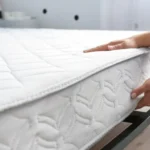A comprehensive review of how VNS devices restore autonomic function by addressing nervous system dysregulation—with expert rankings of the top 4 certified options.

Postural Orthostatic Tachycardia Syndrome (POTS) affects an estimated 1-3 million Americans, causing debilitating symptoms when transitioning from lying to standing. Unlike simple dehydration or deconditioning, POTS represents fundamental autonomic nervous system dysfunction that disrupts cardiovascular regulation, blood flow distribution, and cellular energy metabolism.
Recent neuroscience research has identified a critical mechanism: vagus nerve impairment. When this principal parasympathetic nerve demonstrates reduced activity, your body loses its capacity to modulate heart rate appropriately, maintain cerebral perfusion, and regulate peripheral vascular tone.
This guide examines the relationship between vagus nerve function and POTS symptomatology, and evaluates the leading vagus nerve stimulation (VNS) devices that may help restore autonomic balance and functional capacity.
Symptoms of POTS
POTS is characterized by an excessive increase in heart rate (≥30 bpm in adults, ≥40 bpm in adolescents) within 10 minutes of standing, without orthostatic hypotension. Common manifestations include:
Cardiovascular symptoms:
- Heart rate elevation exceeding 120 bpm upon standing
- Palpitations or sensation of rapid, forceful heartbeat
- Chest discomfort or pressure
- Peripheral vasoconstriction (cold extremities, color changes)
- Presyncope (lightheadedness, near-fainting episodes)
- Syncope (actual loss of consciousness)
Cerebrovascular symptoms:
- Cognitive impairment ("brain fog") particularly when upright
- Visual disturbances (tunnel vision, blurred vision, visual snow)
- Difficulty with concentration and information processing
- Memory consolidation problems
- Headaches (often orthostatic in nature)
Autonomic dysregulation:
- Temperature dysregulation (heat intolerance, inappropriate sweating)
- Gastrointestinal dysmotility (nausea, early satiety, constipation, diarrhea)
- Urinary frequency or urgency
- Tremulousness or internal tremor sensation
- Exercise intolerance with prolonged recovery periods
Systemic symptoms:
- Profound fatigue unrelated to exertion level
- Sleep architecture disruption
- Anxiety (often secondary to physical symptoms)
- Muscle weakness or pain
- Post-exertional malaise lasting 24-48 hours
The functional impact extends beyond symptomatology: inability to maintain employment, educational disruption, social isolation, loss of independence, and significant reduction in quality of life metrics.

POTS Self-Assessment
Evaluate the symptoms you experience with regularity:
Cardiovascular Function
- Heart rate increases ≥30 bpm within 10 minutes of standing
- Palpitations or rapid heartbeat when upright
- Lightheadedness or near-fainting upon standing
- Cold hands and feet despite adequate ambient temperature
- Chest discomfort when upright
Cerebrovascular Function
- Brain fog or cognitive slowing when standing
- Visual disturbances (dimming, tunnel vision, floaters)
- Difficulty maintaining concentration in upright position
- Headaches that improve when lying down
- Memory problems affecting daily function
Postural Tolerance
- Must sit or lie down frequently throughout day
- Cannot stand for more than 10-15 minutes
- Symptoms worsen in warm environments
- Morning symptoms particularly severe
- Shower or bathing triggers symptom exacerbation
autonome Symptome
- Gastrointestinal problems (nausea, bloating, altered motility)
- Temperature regulation difficulties
- Excessive or insufficient sweating
- Tremor or shakiness
- Sleep disruption despite fatigue
Functional Capacity
- Unable to work or attend school full-time
- Exercise causes multi-day symptom flare
- Must plan activities around symptom management
- Significant lifestyle modifications required
- Normal blood pressure readings despite symptoms
Diagnostic History
- Symptoms began after viral illness, pregnancy, surgery, or trauma
- Tilt table test confirmed excessive heart rate increase
- Cardiologist ruled out primary cardiac pathology
- Standard autonomic testing shows abnormalities
- Conventional interventions provide incomplete relief
If you identify with 10+ items, particularly in Cardiovascular, Postural Tolerance, and Autonomic categories, you may have POTS related to vagus nerve dysfunction and parasympathetic withdrawal.
Vagus nerve stimulation may warrant discussion with your healthcare provider as an adjunctive approach.
Die Vagusnervverbindung
Was ist der Vagusnerv?
The vagus nerve (cranial nerve X) is the longest and most complex nerve of the autonomic nervous system, originating in the medulla oblongata and projecting through the neck to innervate the heart, lungs, and gastrointestinal tract. It mediates critical homeostatic functions:
- Cardiovascular regulation (chronotropic and dromotropic modulation)
- Respiratory pattern generation
- Gastrointestinal motility and secretion
- Inflammatory reflex pathway (cholinergic anti-inflammatory pathway)
- Baroreceptor reflex integration
- Metabolic regulation

Das Zwei-Modus-System
Your autonomic nervous system operates through two complementary divisions:
- Sympathetic (thoracolumbar outflow): Increases heart rate, elevates blood pressure, mobilizes glucose, redistributes blood flow to skeletal muscle—activated during stress or perceived threat
- Parasympathetic (vagal outflow): Controlled predominantly by the vagus nerve, reduces heart rate, promotes digestion, facilitates recovery, supports cellular restoration and repair mechanisms
Healthy autonomic function requires dynamic balance between these systems, with rapid shifts based on postural demands, environmental context, and metabolic requirements. However, infection, autoimmune activation, or sustained stress can impair vagal tone, creating sympathetic predominance.
How Vagus Nerve Dysfunction Causes POTS
When your vagus nerve demonstrates reduced activity (low vagal tone):
- Cardiovascular dysregulation: Loss of parasympathetic counterbalance to sympathetic activation causes excessive heart rate acceleration upon standing. Without appropriate vagal braking, tachycardia becomes the primary compensatory mechanism for maintaining cardiac output and cerebral perfusion.
- Impaired baroreceptor sensitivity: The vagus nerve transmits arterial baroreceptor signals to brainstem cardiovascular centers. Dysfunction impairs this feedback loop, preventing appropriate blood pressure and heart rate adjustments during postural changes.
- Peripheral vascular abnormalities: Reduced vagal activity contributes to inadequate vasoconstriction in lower extremities, allowing venous pooling. Approximately 30% of blood volume can pool in the lower body when standing, reducing venous return and triggering compensatory tachycardia.
- Reduced heart rate variability (HRV): HRV serves as a validated biomarker of vagal tone. POTS patients consistently demonstrate markedly reduced HRV, indicating parasympathetic withdrawal and reduced capacity for cardiovascular adaptation.
- Chronic sympathetic activation: Compensatory sympathetic overdrive maintains elevated norepinephrine levels (often 2-3x normal when standing), causing tremor, anxiety, sweating, and progressive receptor desensitization—worsening symptoms over time.
- Inflammatory dysregulation: The vagus nerve controls the cholinergic anti-inflammatory pathway. Dysfunction permits chronic low-grade inflammation, which directly impairs endothelial function, mitochondrial efficiency, and cellular energy production—contributing to fatigue and exercise intolerance.
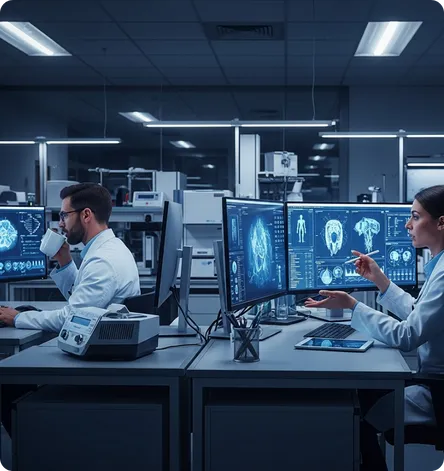
The Scientific Evidence
Published research establishes clear relationships between vagus nerve dysfunction and POTS pathophysiology:
- Autonomic dysfunction profile: Studies document that POTS patients exhibit distinct autonomic abnormalities consistent with impaired vagal and sympathetic cardiovascular control, including decreased vagal baroreflex sensitivity and impaired sympathetic responsiveness. Heart rate variability parameters—validated biomarkers of vagal tone—are markedly reduced compared to healthy controls.
- Autoimmune mechanisms: Growing evidence indicates POTS may represent an autoimmune disorder. Research demonstrates increased expression of autoantibodies against adrenergic and muscarinic acetylcholine receptors in POTS patients. Alpha-1 adrenergic receptor (α-1 AR) autoantibodies are significantly elevated in most individuals with POTS, with approximately 20% showing elevated α1-AR and α2-AR antibodies. These adrenergic receptor autoantibodies correlate significantly with orthostatic intolerance severity—a cardinal POTS feature.
- Clinical trial evidence for vagus nerve stimulation: A randomized, double-blind, placebo-controlled clinical trial conducted at the University of Oklahoma Health Sciences Center (led by Associate Professor Stavros Stavrakis) demonstrated the efficacy of transcutaneous vagus nerve stimulation for POTS:
- Study design: 26 participants (active n=12, placebo n=14) received one hour daily stimulation for 2 months using auricular vagus nerve stimulation technology
- Primary outcome: Postural tachycardia was significantly reduced in the active group versus placebo. Postural heart rate increase was 18±10 bpm in the treatment group compared to 32±14 bpm in placebo (p=0.016)—representing a clinically meaningful 14 bpm difference
- Mechanistic findings: Anti-autonomic autoantibodies were significantly lower in the treatment group after 2 months compared to placebo, providing mechanistic insight into POTS pathophysiology
- Safety profile: No device-related adverse events were reported; all subjects demonstrated excellent adherence to the protocol
- Evidence classification: This represents Level IB evidence according to the Center for Evidence-Based Medicine recommendations—providing strong support for clinical application
- Post-viral POTS connection: Post-viral syndromes, including POTS following SARS-CoV-2 infection, demonstrate marked vagal impairment and elevated inflammatory markers that are normally regulated by vagal anti-inflammatory pathways. Studies indicate 2-14% of COVID-19 survivors develop POTS, with up to 61% reporting POTS-like symptoms following SARS infection.
- Die mechanistische Schlussfolgerung: Restoring vagus nerve function through targeted stimulation addresses the underlying autonomic and immunological pathophysiology of POTS—including both parasympathetic withdrawal and autoantibody-mediated dysfunction—rather than merely suppressing symptoms.
VNS-Geräte als Lösung: So funktionieren sie
The Technology Revolution
Until recently, vagus nerve stimulation required invasive surgical procedures—implanting electrodes directly on the nerve through operations that carried surgical risks, recovery time, and permanent device placement. This confined VNS therapy primarily to severe epilepsy and treatment-resistant depression cases where the benefits justified surgical intervention.
Today’s breakthrough changes everything.
Modern transcutaneous vagus nerve stimulation (tVNS) delivers the same therapeutic electrical impulses to the vagus nerve—facilitating neuroplastic adaptation and restoration of appropriate tone—but completely non-invasively through the skin. No surgery. No implantation. No recovery period.
These advanced devices achieve remarkable effectiveness with an exceptional safety profile, operating through precisely positioned electrodes at two accessible locations:
- Zervikal (Hals): Targeting the cervical branch of the vagus nerve near the carotid artery where the nerve courses superficially beneath the skin
- Ohrmuschel (Ohr): Targeting the auricular branch of the vagus nerve innervating the tragus and cymba conchae—the only place cranial nerves reach the body's surface
This represents a fundamental shift: vagus nerve stimulation therapy that was once confined to operating rooms is now available for daily home use, with clinical-grade precision and zero surgical risk.
Mechanism of Action
When precisely calibrated electrical impulses reach the vagus nerve, they initiate a cascade of neurophysiological responses:
- Neurotransmitter modulation: Stimulation triggers release of acetylcholine at parasympathetic terminals, directly counteracting sympathetic predominance and activating cholinergic anti-inflammatory pathways
- Brainstem nucleus activation: Afferent vagal signals project to the nucleus tractus solitarius, which integrates autonomic regulatory information and modulates cardiovascular control centers in the medulla
- Autonome Neuausrichtung: Consistent stimulation protocols facilitate shift from sympathetic dominance toward parasympathetic restoration, improving heart rate variability and baroreflex sensitivity
- Verbesserung der Neuroplastizität: VNS promotes synaptic reorganization in central autonomic networks, potentially restoring normal cardiovascular regulatory capacity
- Inflammatory suppression: Vagal stimulation activates the cholinergic anti-inflammatory pathway, reducing pro-inflammatory cytokine production (TNF-α, IL-1β, IL-6) that contributes to endothelial dysfunction and symptom perpetuation
klinischen Parameter
Research-validated VNS protocols typically employ:
- Sitzungsdauer: 30-60 minutes daily (allowing for sustained neurophysiological effects)
- Intensität: Individualized to sensory threshold (perceptible but comfortable stimulation)
- Konsistenz: Daily application for minimum 8-12 weeks (neuroplastic changes require sustained intervention)
erwarteten Zeitplan
VNS promotes gradual nervous system adaptation rather than immediate symptom suppression:
- Woche 1–2: Enhanced relaxation response during stimulation sessions, modest improvements in sleep architecture, possible mild reduction in resting heart rate
- Woche 3–4: Noticeable improvements in orthostatic tolerance, reduced tachycardia intensity, decreased presyncope frequency, improved cognitive function when upright
- Monat 2–3: Sustained cardiovascular stability, increased standing tolerance, reduced symptom severity, measurable HRV improvements, decreased reliance on symptom management strategies
- Monat 3+: Restored autonomic balance, functional capacity improvements, ability to resume previously limited activities, enhanced quality of life metrics
Safety Considerations
VNS using transcutaneous approaches is generally well-tolerated in clinical research. Potential transient responses may include:
- Mild tingling sensation at stimulation site
- Temporary muscle tension in neck region (cervical devices)
- Brief lightheadedness (typically resolves with protocol adjustment)
Important limitations: Not appropriate for individuals with cardiac pacemakers, recent acute cardiac events, pregnancy, or history of vagotomy. Healthcare provider consultation is essential prior to initiating any VNS protocol.
Top 4 VNS Devices for POTS
#1: Nurosym
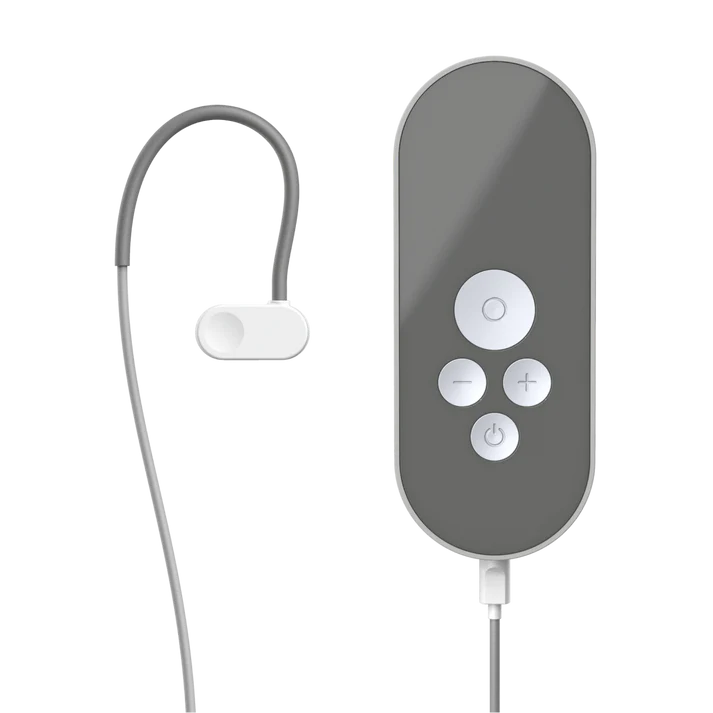
Price: 700 EUR Varies by region (€70 research subsidy available)
Type: Auricular (ear-worn)
Technology: AVNT™ by Parasym
Warum Nr. 1:
- Am umfassendsten validiert: Supported by 50+ peer-reviewed publications from Harvard Medical School, UCLA, and leading research institutions worldwide
- Demonstrated efficacy for autonomic dysfunction: Clinical studies document 61% improvement in vagal tone (HRV metrics), significant reduction in sympathetic overactivation, improved cardiovascular regulation
- Unabhängige Zertifizierung: CE-gekennzeichnetes Medizinprodukt, das strenge Sicherheits- und Leistungsstandards erfüllt—von Dritten überprüft.
- Klinische Einführung: Used by 1000+ healthcare professionals and researchers; integrated into institutional protocols; 4,000,000+ supervised stimulation sessions completed
- Evidenzbasierte Parameter: Stimulation protocols derived from peer-reviewed research, not proprietary guesswork
- Umfassende Unterstützung: 30-day evaluation period, clinical guidance resources, responsive technical support
Empfohlen für: Individuals seeking the most scientifically validated device, particularly those with autonomic dysfunction (POTS, dysautonomia), post-viral syndromes, or those prioritizing evidence over marketing claims.
#2: Truvaga Plus
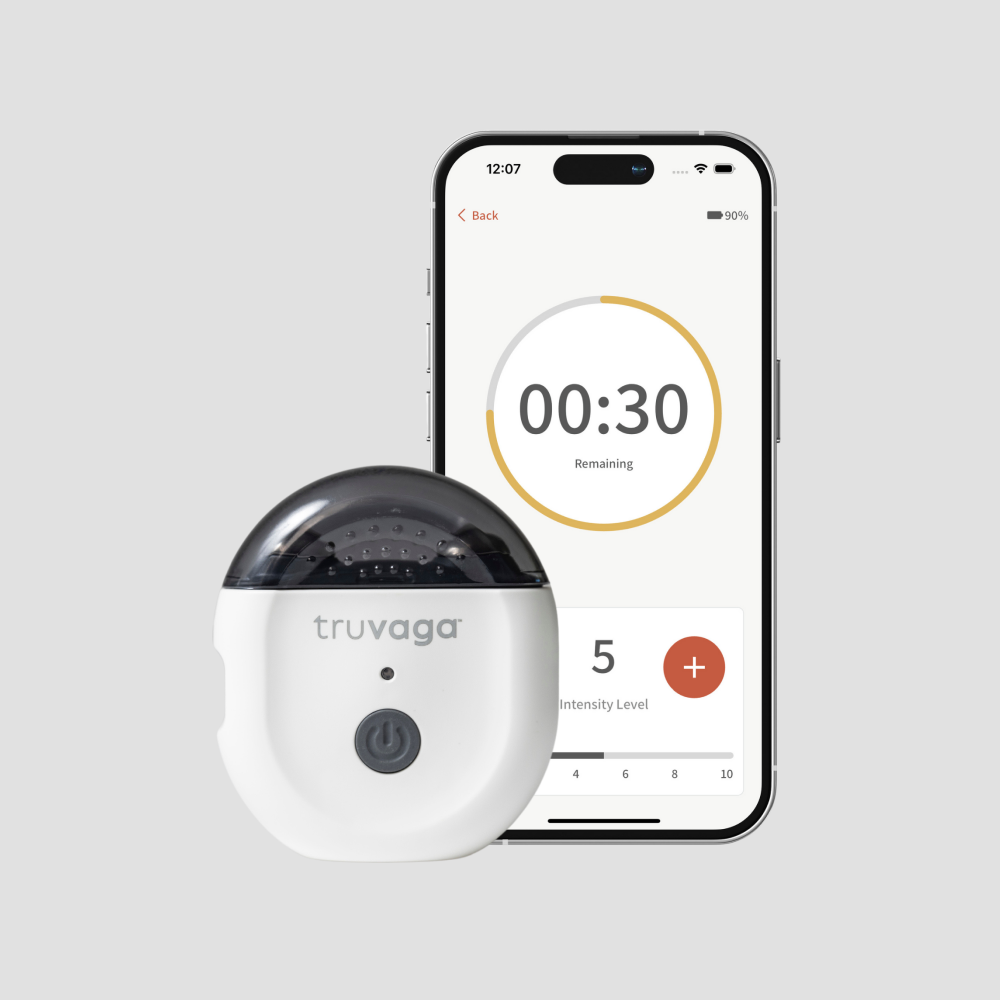
Price: $544+ (device $499 + spray $45/year + potential subscription) Type: Cervical (neck handheld)
Technical note: Shares core technology with gammaCore, an FDA-cleared device for migraine/cluster headache (not POTS). Rapid parasympathetic effects. Straightforward protocol.
Überlegungen: Ongoing costs for conductive spray plus potential app subscription—verify pricing before purchase. Common side effects include muscle spasms, facial droop, lip pull, and headache. Not suitable for users with cardiac conditions, pacemakers, or recent heart issues. Mobile app connectivity problems reported.
Empfohlen für: Those preferring cervical stimulation with FDA-cleared technology lineage (for migraine, not POTS) who can tolerate potential facial muscle spasm side effects.
#3: Pulsetto

Price: $350-$371 (device $269 + gel $81-$102/year) Type: Cervical (hands-free collar)
Vorteile: Freihändiges tragbares Design. HSA/FSA-berechtigt. 2 Jahre Garantieschutz.
Kritische Einschränkungen: No peer-reviewed clinical trials demonstrating efficacy for POTS—only company press releases and retail testimonials. Frequent fit problems create inadequate nerve contact, especially with smaller necks. Users consistently report minimal to no improvement in POTS symptoms compared to research-validated devices.
Not recommended for POTS: The $200-350 price difference seems attractive until you calculate the real cost: months of continued disability while using an unproven device. A $269 device that doesn’t work costs infinitely more than a $700 device that restores your function.
#4: Sinnlich
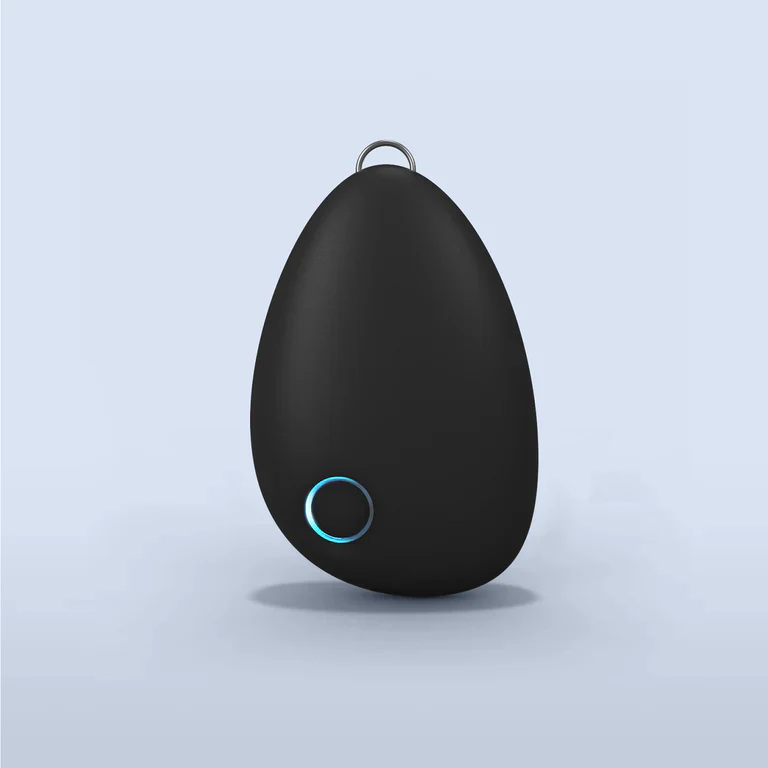
Price: $299-$349 Type: Chest-worn vibrotactile device (not true VNS)
Vorteile: Bequemes Kieseldesign, das auf der Brust getragen wird. Einfache App-Oberfläche mit Klanglandschaften. Niedrigerer Preis. Kann bei anderen Aktivitäten mit einem Nackengurt verwendet werden.
Kritische Unterscheidung: Sensate does not directly stimulate the vagus nerve through electrical impulses like other devices in this comparison. Instead, it uses infrasonic vibrations and bone conduction placed on the chest—an indirect approach targeting general stress reduction rather than specific vagal nerve activation. While bone conduction at the ear has some research supporting vagal stimulation, Sensate’s chest placement lacks scientific substantiation for direct vagus nerve engagement. The mechanism is fundamentally different: actual VNS devices (like Nurosym, Truvaga, and Pulsetto) deliver calibrated electrical signals directly to accessible vagus nerve branches; Sensate delivers vibrations to your sternum hoping for downstream effects.
For POTS patients: This matters significantly. POTS requires restoration of measurable autonomic function—improved heart rate variability, reduced orthostatic tachycardia, enhanced baroreflex sensitivity. General relaxation devices may help with stress management but do not address the underlying vagal dysfunction and autonomic dysregulation driving POTS symptoms. No clinical trials demonstrate Sensate’s efficacy for POTS or autonomic disorders—only company-funded studies showing general stress reduction in healthy volunteers.
Empfohlen für: Those seeking a general relaxation and stress management tool rather than targeted vagus nerve stimulation for autonomic dysfunction. Not recommended for individuals prioritizing evidence-based POTS treatment
*With €70 research subsidy for qualifying participants
**Requires meticulous intensity management and protocol adherence
Schlussfolgerung: Nurosym offers the most comprehensive scientific validation, proven efficacy for autonomic dysfunction including POTS, independent regulatory certification, and optimal balance of research foundation and practical application for those prioritizing evidence-based outcomes.
handeln
POTS related to vagus nerve dysfunction represents a treatable condition. Your autonomic nervous system possesses the capacity for neuroplastic adaptation and restoration of regulatory function.
With support from 50+ clinical studies, independent CE-marking certification, and 4,000,000+ documented stimulation sessions, Nurosym provides scientifically validated potential for restoring autonomic balance and functional capacity.
This information is provided for educational purposes. VNS devices are not intended to diagnose, treat, cure, or prevent any disease. Individuals with POTS should work with qualified healthcare providers to develop comprehensive management strategies. Always consult your physician before beginning any new intervention.
Teilen über:

